The Addition of an Orchard
Orchards have been an important part of the American landscape since the 17oo’s, and many historic apple orchards can be found throughout New England.
Orchards usually have more than just apples; we have 10 kinds of fruit in our small Dewey Square Orchard.
Apples
Nearly all apples are cultivated using a technique called grafting. Grafting means that stems, bearing the desired qualities of the fruit, are attached to healthy root stock of the same plant variety. This technique is used because apples demonstrate a quality called extreme heterozygosity in which the apples display characteristics that are much different than that of their parent DNA. So, in order to cultivate a variety that is widely enjoyed, fruit growers must graft their favorite apples on to healthy root stock. You can read more about fruit tree grafting here: http://pubs.cas.psu.edu/freepubs/pdfs/uj255.pdf. In our orchard, we have six kinds of apples (Malus domestica), all growing from the same roots. Click this link to see a drawing our student, Humberto, created for our records: 6-type apple tree drawing.
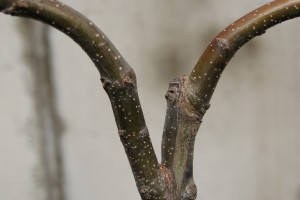
Graft site on apple tree.
Pears
Legend has it, planting a pear tree is good luck. So, we have two in our orchard and they are both Kieffer Pears (Pyrus sp.). Kieffer pears are a hybrid variety that was developed by cross breeding Oriental and European sand pears. To cultivate a strong crop of any kind of fruit, careful attention should be paid to how the tree is cared for in its early years. Here is a great guide on training and pruning fruit trees: http://learningstore.uwex.edu/assets/pdfs/A1959.pdf.
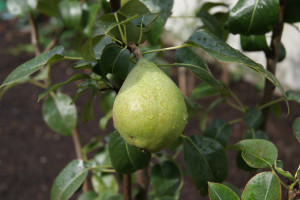
Our Kieffer Pear tree has lots of fruit already!
Blackberries
Blackberries (Rubus sp.) have one of the highest antioxidant levels of all the fruits (http://bit.ly/16GA2ai). Antioxidants protect our bodies against free radicals which can be damaging to cells and can lead to diseases such as heart disease and cancer. Blackberries are also high in vitamin K, an important factor in blood clotting. Nobel Prize winning poet, Seamus Heaney, wrote a poem about blackberry picking and you can listen to it here: http://www.npr.org/templates/story/story.php?storyId=4818965.
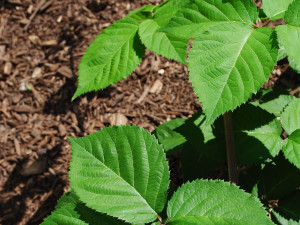
Blackberry foliage
Paw Paw
We have two Common Paw Paw (Asimina triloba) trees in our orchard. The tree grows really well in wet soil and is native to the Northeast region. When the large purple flowers are fertilized they turn into big edible fruits kind of like bananas. Chilled Paw Paw fruit is even said to be George Washington’s favorite dessert! You can read more about the Paw Paw here: http://www.crfg.org/pubs/ff/pawpaw.html.
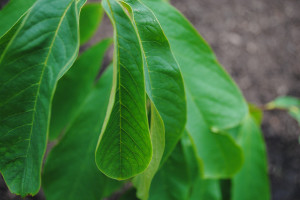
Leaves of the Paw Paw tree
Plum
We have two varieties of plums growing in our orchard; the Santa Rosa Plum (Prunus salicina ‘Santa Rosa’, and the Italian Prune Plum (Prunus domesticus). Both plums are delicious when eaten raw but the Italian Prune Plums are specially grown to be dried and eaten as prunes. If you tasted each side by side you might find that the Santa Rosa Plum is slightly sweeter and less acidic than the Italian Prune Plum. You can read more about the care of plum trees here: http://www.almanac.com/plant/plums
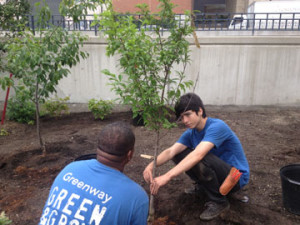
Humberto and Kent planting a Plum tree.
Let us know if you have any questions about our orchard or our garden by contacting us at [email protected]. Enjoy the gardens!
